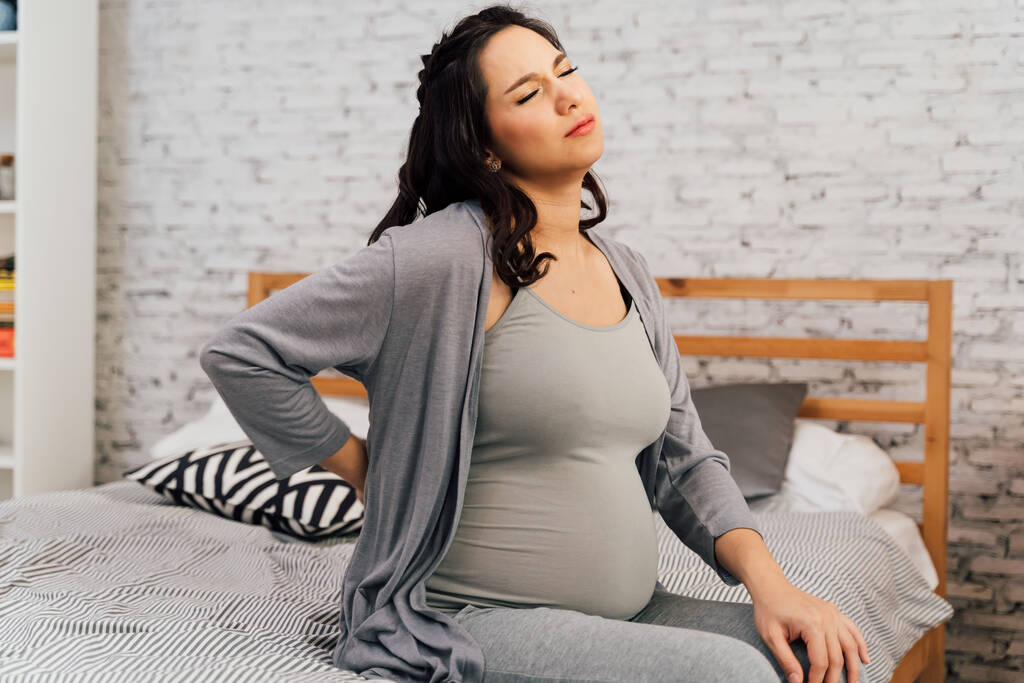Learn about the key distinctions between pelvic girdle pain and regular back pain during pregnancy.
Understanding the Difference Between Pelvic Girdle Pain and Regular Back Pain During Pregnancy
If you’re pregnant, you’re likely to experience a whole array of discomforts and aches. Two common ones are pelvic girdle pain and regular back pain. While they may feel similar at times, it’s vital to understand their differences to seek the right treatment and care. So, let’s dive into the realm of discomfort and gain a clearer understanding of pelvic girdle pain and regular back pain during pregnancy.

Defining Pelvic Girdle Pain and Regular Back Pain
If you’ve been searching high and low for an explanation, look no further! Let’s start by defining these pesky pregnancy pains.
During pregnancy, a woman’s body goes through numerous changes to accommodate the growing baby. These changes can sometimes lead to discomfort and pain, particularly in the pelvic and back regions. Two common types of pain experienced during pregnancy are pelvic girdle pain and regular back pain.
What is Pelvic Girdle Pain?
Pelvic girdle pain, also known as symphysis pubis dysfunction (SPD), is a condition that occurs when the joints in the pelvis become stiff or inflamed. This condition is primarily caused by the hormone relaxin, which is released during pregnancy to loosen the ligaments in the pelvis in preparation for childbirth. The increased flexibility in the pelvic joints, combined with the weight of the growing baby, can lead to pain and discomfort.
The pain associated with pelvic girdle pain is often felt in the lower back, buttocks, hips, and pelvic region. It can range from a dull ache to sharp, shooting pain. Activities such as walking, climbing stairs, or even turning over in bed can exacerbate the pain. Women with pelvic girdle pain may also experience difficulty in performing daily activities and have difficulty finding a comfortable position to sit or lie down.
It is important to note that pelvic girdle pain is a common condition during pregnancy, affecting approximately 20% of pregnant women. While it can be uncomfortable and disruptive, it is usually temporary and resolves after childbirth.
What is Regular Back Pain?
Regular back pain, on the other hand, is a type of pain that can occur during pregnancy but is not exclusive to pregnancy. It is a general discomfort or ache in the back that can be experienced by individuals even before they were expecting. This type of pain is often caused by various factors such as poor posture, muscle strain, or hormonal changes.
Pregnancy can exacerbate regular back pain due to the additional weight and changes in posture that occur as the baby grows. The hormone relaxin, which is released during pregnancy, can also contribute to increased joint laxity and potential muscle imbalances, leading to back pain.
The symptoms of regular back pain can vary from person to person but commonly include aching or stiffness in the lower back. The pain may worsen with certain movements or activities and can be relieved through rest or gentle stretching exercises.
It is important to differentiate regular back pain from more serious conditions such as herniated discs or sciatica, which may require medical intervention. If the pain is severe, persistent, or accompanied by other concerning symptoms, it is recommended to consult a healthcare professional for proper evaluation and guidance.
In conclusion, pelvic girdle pain and regular back pain are two common types of discomfort experienced during pregnancy. Pelvic girdle pain is specifically related to the joints in the pelvis becoming stiff or inflamed due to hormonal changes and the weight of the growing baby. Regular back pain, on the other hand, is a general discomfort or ache in the back that can be caused by various factors such as poor posture, muscle strain, or hormonal changes. Understanding the differences between these two types of pain can help pregnant women better manage and alleviate their discomfort.
Causes of Pelvic Girdle Pain and Regular Back Pain During Pregnancy
Now that we understand the basics, let’s explore what causes these discomforts during pregnancy.
Factors Leading to Pelvic Girdle Pain
During pregnancy, the release of hormones like relaxin can cause the ligaments in the pelvic area to become more flexible. This increased mobility can sometimes put stress on the joints and lead to pelvic girdle pain.
However, there are other factors that can contribute to the development of pelvic girdle pain. One such factor is the increased weight that pregnant women carry. As the baby grows, the weight distribution in the body changes, putting more pressure on the pelvic area. This added pressure can strain the ligaments and muscles, leading to discomfort and pain.
Additionally, changes in posture during pregnancy can also contribute to pelvic girdle pain. As the belly grows, pregnant women often adjust their posture to accommodate the changing weight distribution. This adjustment can put strain on the pelvic joints and exacerbate the pain.
Furthermore, certain activities or movements can trigger or worsen pelvic girdle pain. Activities that involve repetitive movements, such as walking or climbing stairs, can put stress on the pelvic area and increase the discomfort. Similarly, sudden movements or lifting heavy objects can also strain the ligaments and exacerbate the pain.
Factors Leading to Regular Back Pain
Regular back pain can have a variety of causes. The extra weight you’re carrying, changes in your center of gravity, and hormonal fluctuations can all contribute to those nagging backaches.
As mentioned earlier, the additional weight that pregnant women carry during pregnancy can put strain on the back muscles and spine. The spine is responsible for supporting the body’s weight, and the added pressure can lead to discomfort and pain.
Moreover, changes in the center of gravity can also contribute to back pain during pregnancy. As the belly grows, the body’s center of gravity shifts forward, causing the back muscles to work harder to maintain balance. This increased workload can result in muscle fatigue and back pain.
In addition to weight and changes in center of gravity, hormonal fluctuations can also play a role in causing back pain. Hormones like relaxin, which are released during pregnancy to prepare the body for childbirth, can loosen the ligaments and joints in the body. While this is necessary for the birthing process, it can also lead to instability in the spine and contribute to back pain.
Furthermore, poor posture and improper body mechanics can exacerbate back pain during pregnancy. As the belly grows, pregnant women may find themselves slouching or adopting awkward positions to alleviate discomfort. However, these postural changes can strain the back muscles and lead to increased pain.
It is important to note that every woman’s experience with pelvic girdle pain and regular back pain during pregnancy is unique. The severity and duration of the discomfort can vary from person to person. If you are experiencing persistent or severe pain, it is recommended to consult with a healthcare professional for proper evaluation and guidance.
Symptoms of Pelvic Girdle Pain and Regular Back Pain
Okay, we’ve understood what causes these discomforts, but how can we recognize and distinguish between them?

Identifying Symptoms of Pelvic Girdle Pain
Pelvic girdle pain usually manifests as a sharp, stabbing sensation in the pelvic area, hips, or buttocks. It might even radiate to the thighs or groin. You might find it difficult to walk, climb stairs, or even turn in bed.
When experiencing pelvic girdle pain, you may also notice a feeling of instability in the pelvic region. This instability can make it challenging to maintain a stable posture or perform activities that involve weight-bearing on the affected side.
In some cases, pelvic girdle pain can be accompanied by a clicking or grinding sensation in the pelvic joints. This sensation can be unsettling and may cause additional discomfort.
Furthermore, individuals with pelvic girdle pain may experience difficulty in finding a comfortable position while sitting or standing for prolonged periods. The pain can intensify with certain movements, such as lifting heavy objects or bending forward.
Recognizing Symptoms of Regular Back Pain
Regular back pain, on the other hand, is generally more spread out. It often presents as a dull ache in the lower back, sometimes accompanied by muscle tension or spasms.
When dealing with regular back pain, you may also experience stiffness in the affected area. This stiffness can make it challenging to bend, twist, or engage in activities that require flexibility.
In some cases, regular back pain can be aggravated by prolonged sitting or standing. Maintaining the same position for an extended period may exacerbate the pain and lead to discomfort.
Additionally, regular back pain can cause referred pain, which means the pain may radiate to other parts of the body. For example, you may feel discomfort in the buttocks, thighs, or even down to the legs.
It is important to note that regular back pain can have various causes, such as muscle strains, herniated discs, or spinal conditions. Therefore, it is essential to consult a healthcare professional for an accurate diagnosis and appropriate treatment.
Diagnosis and Treatment Options
Enough with the symptoms – now let’s talk about how these discomforts are diagnosed and treated.
How is Pelvic Girdle Pain Diagnosed?
When it comes to diagnosing pelvic girdle pain, your healthcare provider will consider your medical history, conduct a physical examination, and may even order additional imaging tests to rule out other potential causes.
How is Regular Back Pain Diagnosed?
For regular back pain, a clinical evaluation is often enough. Your healthcare provider may perform a physical examination and ask questions about your symptoms to pinpoint potential causes for your discomfort.
Treatment Options for Pelvic Girdle Pain
Managing pelvic girdle pain usually involves a combination of strategies. These may include exercises to strengthen the pelvic floor and stabilizing muscles, physiotherapy, pain-relieving techniques, and the use of support devices like belts or crutches.
Treatment Options for Regular Back Pain
When it comes to regular back pain, there’s also a variety of treatment options. These range from lifestyle adjustments, such as maintaining good posture and avoiding heavy lifting, to massage therapy, gentle exercises, and heat or cold packs.
Prevention and Management Tips
Now that we’ve covered the essentials of diagnosis and treatment, let’s talk about some prevention and management tips to help you steer clear of discomfort or find relief when it strikes.
Preventing Pelvic Girdle Pain and Regular Back Pain
When it comes to preventing both pelvic girdle pain and regular back pain, regular exercise can make a world of difference. Maintaining good posture, incorporating gentle stretches, and avoiding excessive strain on your body are all smart moves during pregnancy.
Managing Pelvic Girdle Pain and Regular Back Pain at Home
At home, you can also look into techniques such as using pillows for support while sleeping, taking warm baths, practicing relaxation exercises, and seeking the help of prenatal yoga or massage therapists specializing in pregnancy-related discomforts.
Now that you have a clearer understanding of the differences between pelvic girdle pain and regular back pain during pregnancy, you can better navigate discomfort and seek appropriate care. Remember, each pregnancy is unique, and if you have concerns or need guidance, always consult with your healthcare provider. Stay strong and enjoy the incredible journey of bringing new life into the world!



